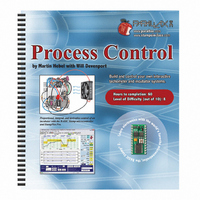122-28176 Parallax Inc, 122-28176 Datasheet - Page 232

122-28176
Manufacturer Part Number
122-28176
Description
GUIDE STUDENT PROCESS CONTROL
Manufacturer
Parallax Inc
Specifications of 122-28176
Accessory Type
Manual
Product
Microcontroller Accessories
Lead Free Status / RoHS Status
Contains lead / RoHS non-compliant
For Use With/related Products
Propeller Education (PE) Kit
Lead Free Status / RoHS Status
Lead free / RoHS Compliant, Contains lead / RoHS non-compliant
- Current page: 232 of 330
- Download datasheet (11Mb)
desired output of the process. The controller evaluates the two pieces of data. Based on
this evaluation, the controller initiates action on the power interface. This block provides
the signal conditioning at the controller’s output. Chapter 5 discussed several methods of
driving power interface circuits. The power interface has the ability to control the
actuator. This may be a relay, a solenoid valve, a motor drive, etc. The action taken by
the actuator is sufficient to drive the actual output toward the desired value.
As you can see, this control scenario forms a loop, a closed-loop. Furthermore, since it is
the process’s output that is being measured, and its value determines actuator settings, it
is a feedback closed-loop system. The input changes the process output → the output is
monitored for evaluation → the evaluation changes the input → changes the process
output, etc., etc.
The type of reaction that takes place upon evaluation of the input defines the process-
control mode. There are five common control modes. They are on-off, on-off with
differential gap, proportional, integral, and derivative. The fundamental characteristic that
distinguishes each control mode is listed below in Table 7-1.
On-off
On-off with differential
gap
Proportional
Integral
Derivative
Process Control Mode
Table 7-1: Five Common Control Modes
Is the variable above or below
a specific desired value?
Is the variable above or below
a range defined by an upper
and lower limit?
How far is the measured
variable away from the desired
value?
Does the error still persist?
How fast is the error
occurring?
Evaluation
Drive the output fully ON or
fully OFF.
Output is turned fully ON and
fully OFF to drive the
measured value through a
range.
Take a degree of action
relative to the magnitude of
the error.
Continue taking more forceful
action for the duration the
error exists.
Take action based on the rate
at which the error is occurring.
Action
Related parts for 122-28176
Image
Part Number
Description
Manufacturer
Datasheet
Request
R

Part Number:
Description:
MANUAL FOR SUMOBOT
Manufacturer:
Parallax Inc
Datasheet:

Part Number:
Description:
GUIDE STUDENT SMART SENSORS
Manufacturer:
Parallax Inc
Datasheet:

Part Number:
Description:
MANUAL PROPELLER
Manufacturer:
Parallax Inc
Datasheet:

Part Number:
Description:
LEAD WIRES FLYING CABLE III/IV
Manufacturer:
Xilinx Inc
Datasheet:

Part Number:
Description:
BOARD ADAPTER AND FLY LEADS
Manufacturer:
Xilinx Inc
Datasheet:

Part Number:
Description:
PLATFORM CABLE USB II
Manufacturer:
Xilinx Inc
Datasheet:

Part Number:
Description:
KIT STARTER COOLRUNNER-II BUNDLE
Manufacturer:
Xilinx Inc
Datasheet:

Part Number:
Description:
Microcontroller Modules & Accessories DISCONTINUED BY PARALLAX
Manufacturer:
Parallax Inc

Part Number:
Description:
Microcontroller Modules & Accessories DISCONTINUED BY PARALLAX
Manufacturer:
Parallax Inc

Part Number:
Description:
BOOK UNDERSTANDING SIGNALS
Manufacturer:
Parallax Inc
Datasheet:

Part Number:
Description:
BOARD EXPERIMENT+LCD NX-1000
Manufacturer:
Parallax Inc
Datasheet:

Part Number:
Description:
IC MCU 2K FLASH 50MHZ SO-18
Manufacturer:
Parallax Inc
Datasheet:












